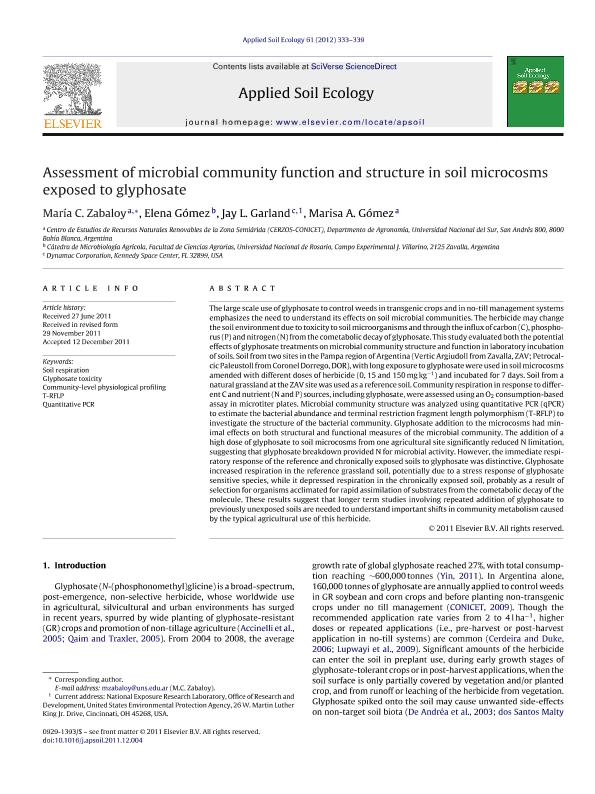Artículo
Assessment of microbial community function and structure in soil microcosms exposed to glyphosate
Fecha de publicación:
10/2012
Editorial:
Elsevier Science
Revista:
Applied Soil Ecology
ISSN:
0929-1393
Idioma:
Inglés
Tipo de recurso:
Artículo publicado
Clasificación temática:
Resumen
The large scale use of glyphosate to control weeds in transgenic crops and in no-till management systems emphasizes the need to understand its effects on soil microbial communities. The herbicide may change the soil environment due to toxicity to soil microorganisms and through the influx of carbon (C), phosphorus (P) and nitrogen (N) from the cometabolic decay of glyphosate. This study evaluated both the potential effects of glyphosate treatments on microbial community structure and function in laboratory incubation of soils. Soil from two sites in the Pampa region of Argentina (Vertic Argiudoll from Zavalla, ZAV; Petrocalcic Paleustoll from Coronel Dorrego, DOR), with long exposure to glyphosate were used in soil microcosms amended with different doses of herbicide (0, 15 and 150mgkg -1) and incubated for 7 days. Soil from a natural grassland at the ZAV site was used as a reference soil. Community respiration in response to different C and nutrient (N and P) sources, including glyphosate, were assessed using an O 2 consumption-based assay in microtiter plates. Microbial community structure was analyzed using quantitative PCR (qPCR) to estimate the bacterial abundance and terminal restriction fragment length polymorphism (T-RFLP) to investigate the structure of the bacterial community. Glyphosate addition to the microcosms had minimal effects on both structural and functional measures of the microbial community. The addition of a high dose of glyphosate to soil microcosms from one agricultural site significantly reduced N limitation, suggesting that glyphosate breakdown provided N for microbial activity. However, the immediate respiratory response of the reference and chronically exposed soils to glyphosate was distinctive. Glyphosate increased respiration in the reference grassland soil, potentially due to a stress response of glyphosate sensitive species, while it depressed respiration in the chronically exposed soil, probably as a result of selection for organisms acclimated for rapid assimilation of substrates from the cometabolic decay of the molecule. These results suggest that longer term studies involving repeated addition of glyphosate to previously unexposed soils are needed to understand important shifts in community metabolism caused by the typical agricultural use of this herbicide.
Archivos asociados
Licencia
Identificadores
Colecciones
Articulos(CERZOS)
Articulos de CENTRO REC.NAT.RENOVABLES DE ZONA SEMIARIDA(I)
Articulos de CENTRO REC.NAT.RENOVABLES DE ZONA SEMIARIDA(I)
Citación
Zabaloy, Maria Celina; Gomez, Elena del Valle; Garland, Jay L.; Gomez, Marisa Anahi; Assessment of microbial community function and structure in soil microcosms exposed to glyphosate; Elsevier Science; Applied Soil Ecology; 61; 10-2012; 333-339
Compartir
Altmétricas




